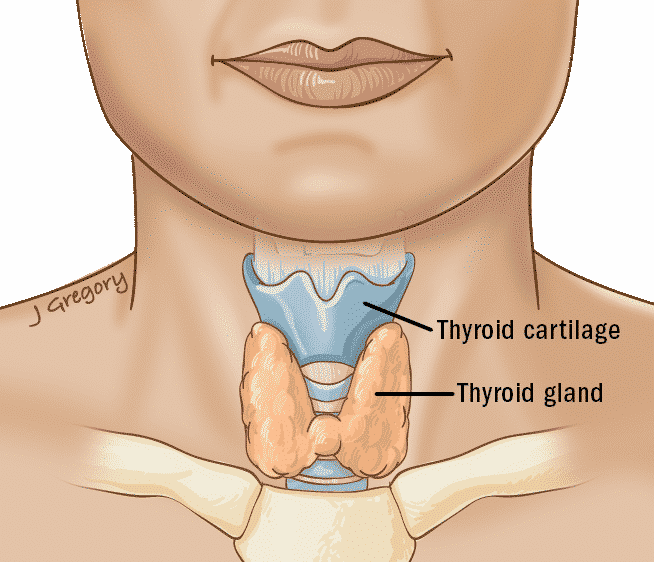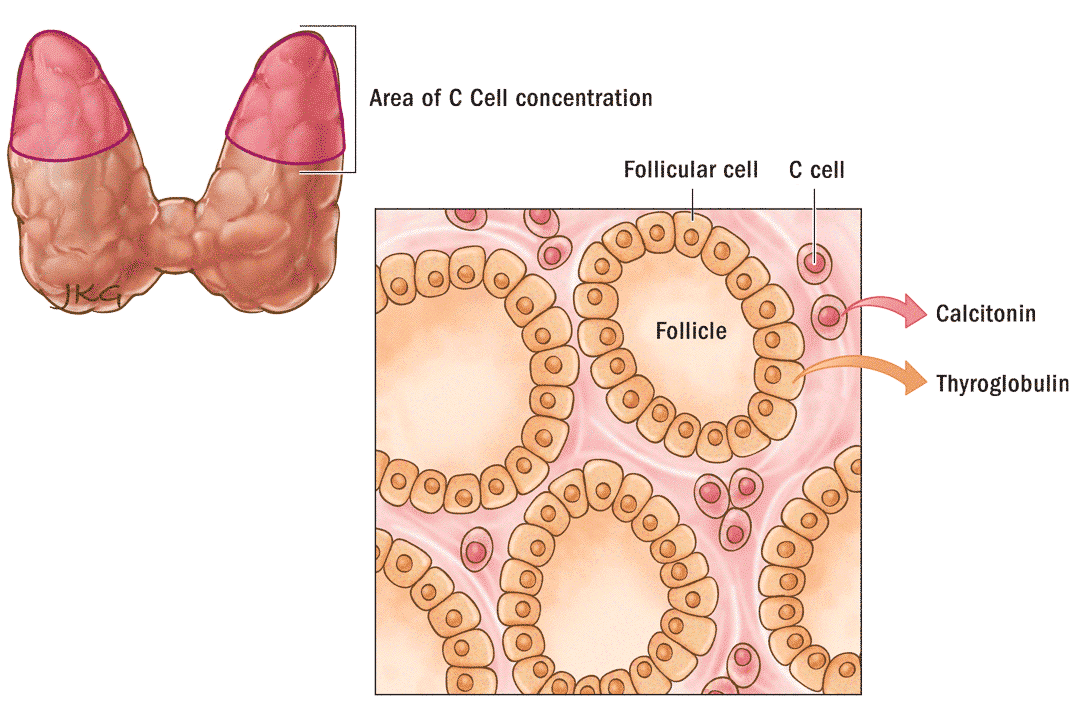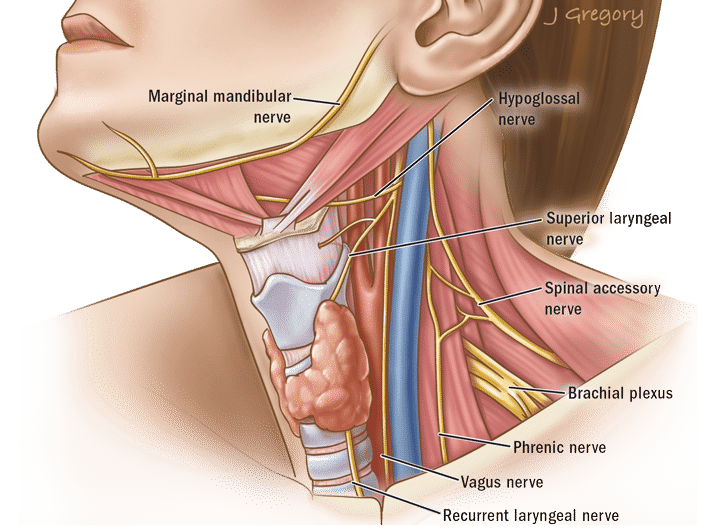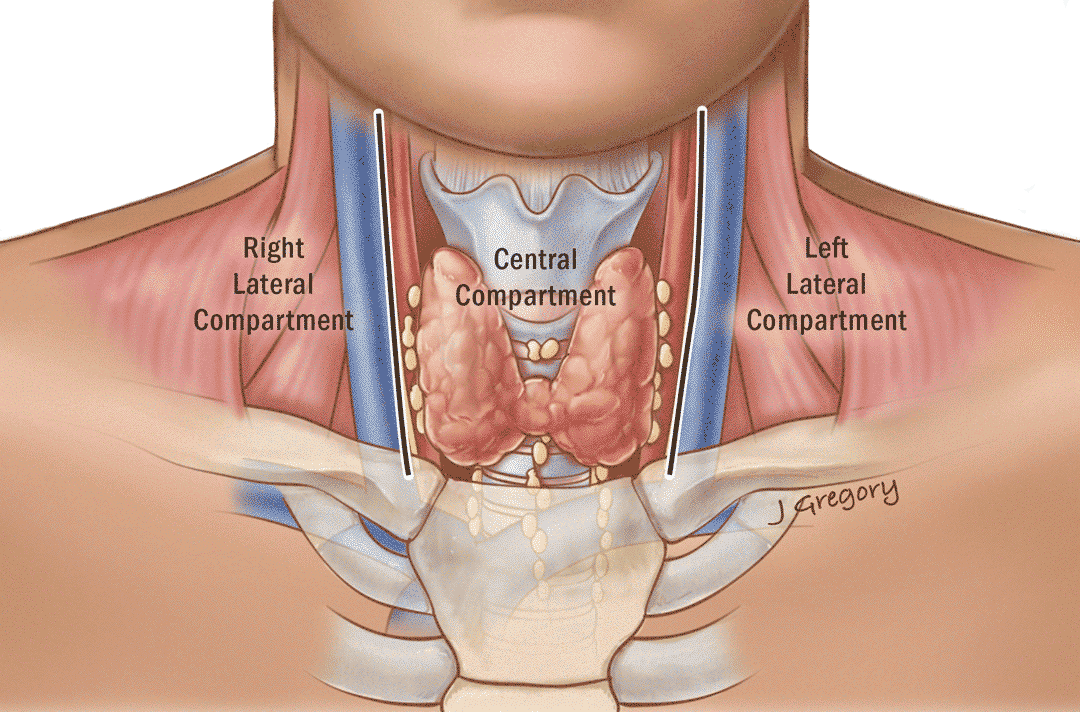In order to better understand well-differentiated thyroid cancer, it is important to first understand the anatomy of the thyroid gland and the important surrounding structures. The thyroid gland sits in the midline of the neck, just beneath the skin and a few layers of thin muscles. It has 2 lobes, the right and left lobe, which are connected in the midline by an isthmus. Occasionally, the thyroid also has a prominent pyramidal lobe that extends upwards towards the hyoid bone and base of tongue. The pyramidal lobe is located in the midline in front of the larynx and connects to the isthmus.
Thyroid Hormones
The thyroid gland secretes thyroid hormones, which are important in regulating many metabolic functions of the body. These thyroid hormone levels are closely controlled by thyroid stimulating hormone (TSH), which is produced by the pituitary gland and causes cells to produce thyroid hormone. The pituitary gland responds to levels of thyroid hormones in the bloodstream, producing more or less TSH to maintain metabolic function. However, thyroid hormones can still sometimes be over or under-produced. A simple blood test can measure these hormone levels. Cases of overproduction create hyperthyroidism, and cases of underproduction create hypothyroidism.

What You Need to Know About the Thyroid Gland
The gland is made up of follicular cells that take up iodine and produce thyroid hormone, which is stored in follicles inside the thyroid. The thyroid is also made up of another type of cell called parafollicular cells (C-cells). These cells form a hormone called calcitonin, which helps with calcium regulation. Cancer of these C-cells is called medullary thyroid carcinoma and will be discussed in a different section.
The blood supply to the thyroid gland comes from the inferior thyroid artery, a branch of the thyrocervical trunk, and the superior thyroid artery, a branch of the external carotid artery. In some rare cases, there exists an artery called the ima artery, which runs from below the clavicles on the top surface of the trachea towards the isthmus portion of the thyroid gland.

What are the Parathyroid Glands?

On the backside of the thyroid gland are four parathyroid glands (two on each side). These are, much like the thyroid gland, endocrine glands that produce and secrete hormones. Through the secretion of the parathyroid hormone, the parathyroid glands regulate calcium levels in the blood and bones. Additionally, parathyroid hormone controls levels of calcium absorption from the diet and calcium excretion from the kidneys into the urine. During thyroid surgery, it’s important for surgeons to carefully separate the parathyroids from the thyroid to maintain normal levels of parathyroid hormone in the blood.
The Laryngeal Nerves
The recurrent laryngeal nerves (one on each side) run upward from the vagus nerve toward the voice box (larynx) in the groove between the trachea (windpipe) and esophagus which is just deep to the thyroid gland. This nerve moves the vocal cords and is responsible for speaking and control of the vocal cords during breathing. In extremely rare cases, the right recurrent laryngeal nerve can emerge straight down from the vagus nerve. This is called a non-recurrent laryngeal nerve because it does not come from below. It is important for surgeons to locate and protect this nerve during surgery.
The superior laryngeal nerves (one on each side) run downward from the vagus nerve. The external branch supplies the cricothyroid muscle and helps with changing voice pitch and volume, whereas the internal branch controls the sensation of the larynx and aids in normal swallowing by protecting against aspiration.
Neck Compartments & Lymph Nodes in the Thyroid
The main lymph nodes associated with the thyroid are the central compartment lymph nodes (levels VI and VII) which lie in the middle portion of the neck in the tissue surrounding the thyroid gland. Occasionally, thyroid cancers can spread to the lateral neck or retropharyngeal lymph nodes (situated behind the upper part of the pharynx) as well.

Summary
The thyroid gland is a small, butterfly-shaped gland that sits in the front of the neck just below the Adam’s apple. The thyroid is responsible for producing hormones that regulate metabolism and help to control heart rate, blood pressure, and body temperature. There are several different types of thyroid cancer, each with its own set of symptoms. It’s important to have regular checkups with your doctor to screen for any signs or symptoms of thyroid cancer. If you do have cancer, early detection and treatment is key to successful outcomes. Continue to the next section “Causes, Signs & Symptoms” below.













